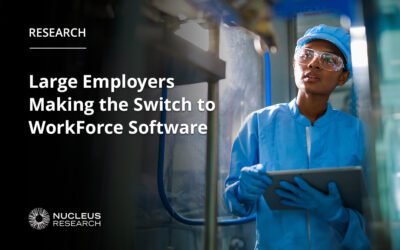5 Scheduling Questions You Need to Ask Before Choosing a Vendor

Multifaceted organizations must employ scheduling approaches that cover the needs of different teams across multiple industries and geographical regions.
So, you don’t want to settle for a vendor that creates gaps in functionality that require error-prone manual workarounds. You want to rely on one vendor for flexible options that address all your employee scheduling requirements while improving the employee experience. Our Third Annual Global Employee Experience Study highlights the urgency for employers to invest in modern workforce management solutions that meet the employees’ demands while meeting business goals.
Suppose you’re ready to upgrade scheduling at your organization and strengthen your workforce experience by giving them more control and flexibility over their schedules. If so, you should ask these five questions to prospective vendors to decide whether they are a true partner in your success.
Question 1: How are you incorporating emerging technology and trends to support innovation?
A notable example is artificial intelligence (AI). Nucleus Research’s WFM Technology Value Matrix says workforce management “leaders have continued investments in AI and machine learning (ML), specifically around forecasting capabilities and the introduction of Generative AI-powered virtual assistants.” And nearly every vendor out there is talking about AI, but to what extent have they put it into practice? Are they taking a reactive or proactive approach? Are scenarios pre-programmed, or is there a machine learning element to their execution?
For example, a machine learning approach to labor forecasting looks at historical patterns and trends, applies its learnings to the current environment, and projects the impact on staffing levels accordingly. As new data is received, it can forecast demand and provide insights into potential adjustments to staffing levels for even more precise alignment with business KPIs (Key Performance Indicators).
Question 2: In a period of disruption, how will your employee scheduling software adapt to keep operations running smoothly?
Organizations are accelerating digital transformation and focusing on employee safety, despite ongoing challenges like supply chain vulnerabilities and labor shortages. An automated scheduling solution that incorporates machine learning powered labor forecasting can help organizations swiftly adapt.
Of course, the unexpected can take many forms, from uncertainties to new opportunities for growth. For example, a utility company in an emergency weather event may need a solution that can gauge their entire workforce and identify individuals that are best suited to fill gaps in coverage to speed up the restoration of power. This may include asking employees to perform duties outside of their normal responsibilities.
Elsewhere, a manufacturer that solely produces goods decides now is the opportunity to launch retail operations to sell goods direct. In this case, a solution that is purpose-built for manufacturing would not be the right fit for their retail operations.
Question 3: How does your solution improve the employee experience?
An elevated employee experience encompasses everything from implementing predictive scheduling and flexible working arrangements to career development planning. A robust scheduling solution can enhance these efforts and even take on some of the heavy lifting.
For example, employees in highly variable work environments don’t always have the luxury of a consistent schedule. An automated scheduling solution that incorporates labor forecasting publishes optimized schedules well in advance and gives employees the time they need to organize personal obligations. When conflicts do arise, employees start their own shift swapping to ease administrative burden while still ensuring their replacement has the right qualifications.
The solution should also have the capability to send pro-active alerts when work limits are approaching, or if employees are not taking the required breaks or vacation time.
For career progression planning, look for features that enforce qualifications and support schedules that allow for mentorship. Optimized schedules should place top performers with less experienced employees to encourage knowledge transfer, while preventing a negative performance impact during peak business periods.
Question 4: How does your scheduling solution simplify compliance with labor rules?
Prevention is key to safeguarding employee rights. Non-compliant practices are expensive. They can result in litigation costs, fines, penalties, and lost productivity, and your brand reputation can take a major hit — making it difficult to attract and keep both employees and customers. At the very least, a scheduling solution should enforce legislation, employment agreements, and industry standards, like work hour limits, breaks, rest periods, and minimum qualifications during the scheduling process.
But what happens when things don’t go as planned, and the employee’s actual hours vary from their scheduled hours? Your scheduling, time and attendance, and absence practices need to be interwoven so potential risks can be predicted and mitigated before it is too late. For example, if an employee works late, you should be alerted if they are at risk of not getting the required rest between shifts. Then, you have the information needed to decide whether to send the employee home or adjust their next shift to remain compliant.
In addition to being an excellent convenience, some employment agreements and region-specific legislation dictate notification periods for publishing schedules and changes. Notification compliance is another benefit of incorporating machine learning into your labor forecasting practices.
Question 5: How does your solution accelerate smarter scheduling decisions?
Data drives decisions, and access to the right data across all your critical systems can offer valuable insights into your workforce.
For example, a solution that accepts critical business driver data from third-party systems is able to create accurate labor forecasts weeks or months in advance. This allows you to generate and populate schedules and find any potential talent shortages or surpluses. This could trigger increased recruiting efforts or give leaders time to build a strategy on how idle workers can be used on special projects or other activities.
Re-Imagine Employee Scheduling
Asking the right questions is the first step to finding the right solution for a complex enterprise with multifaceted requirements. Be sure to cover your needs today and your aspirations for the future, with open-ended questions that invite prospective vendors to prove their value. Otherwise, you may find yourself without valuable insights into the efficiency, productivity, and engagement of your workforce.
It’s time to evaluate your workforce management software. Our Essential Guide to Selecting Workforce Management Software can keep your organization on track and improve the employee experience.
Subscribe to The WorkForce Blog
Learn the art and science of maintaining productive, happy, engaged employees.
Discover More
Nucleus Insights from WorkForce Customers Research Note
Nucleus Research interviews WorkForce customers who validate why we’re ranked the #1 WFM enterprise vendor for 10 consecutive years.
Elevate Employee Experience: Checklist for Operational Leaders
Get the practical steps and technology functionalities operation leaders need to improve their employees’ work experiences.
Streamlining Complex Workforce Compliance Requirements Boosts Productivity
Discover how workforce compliance software helps EMEA organisations navigate complex legislation, enhance compliance and boost operational efficiency.



